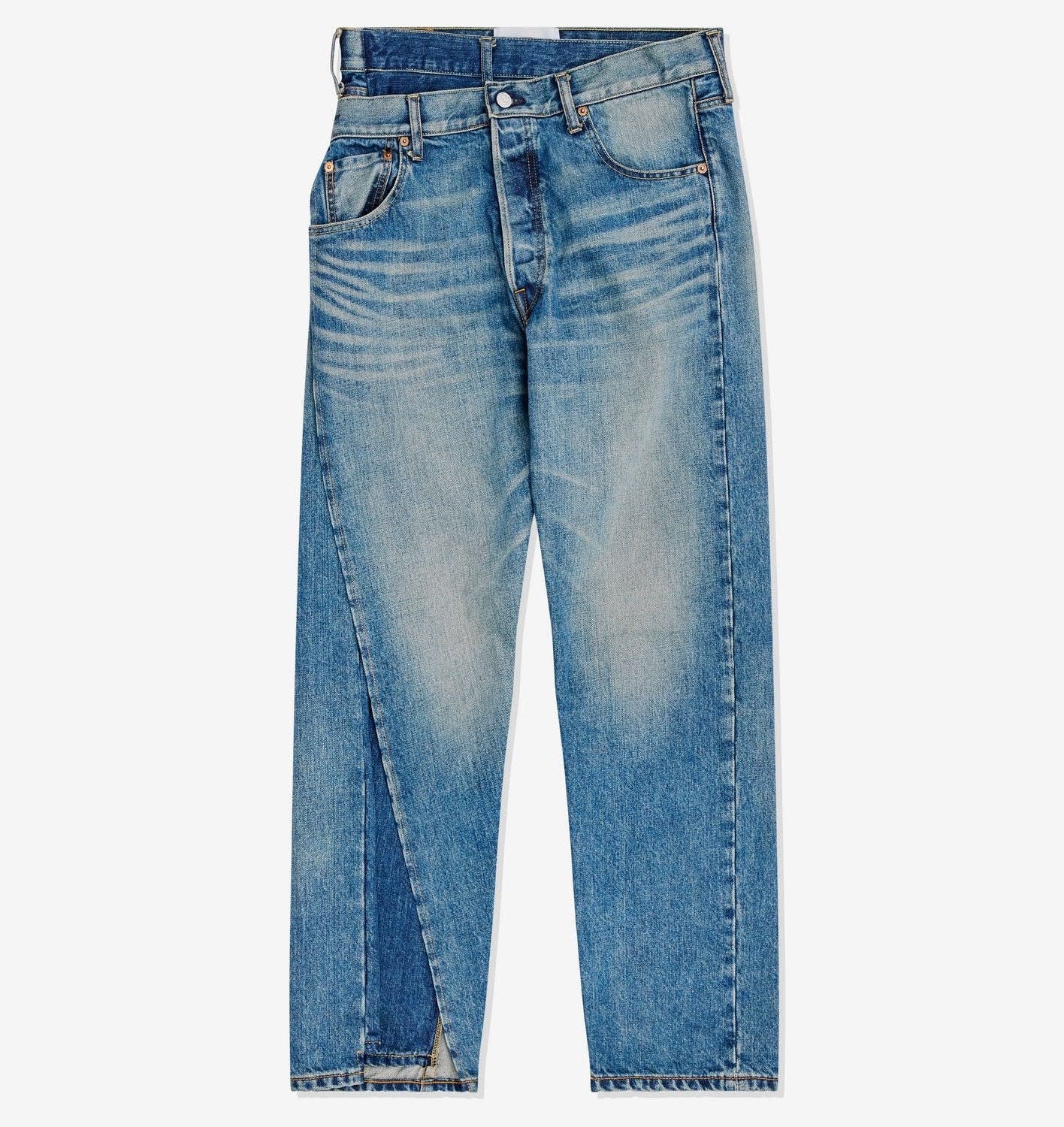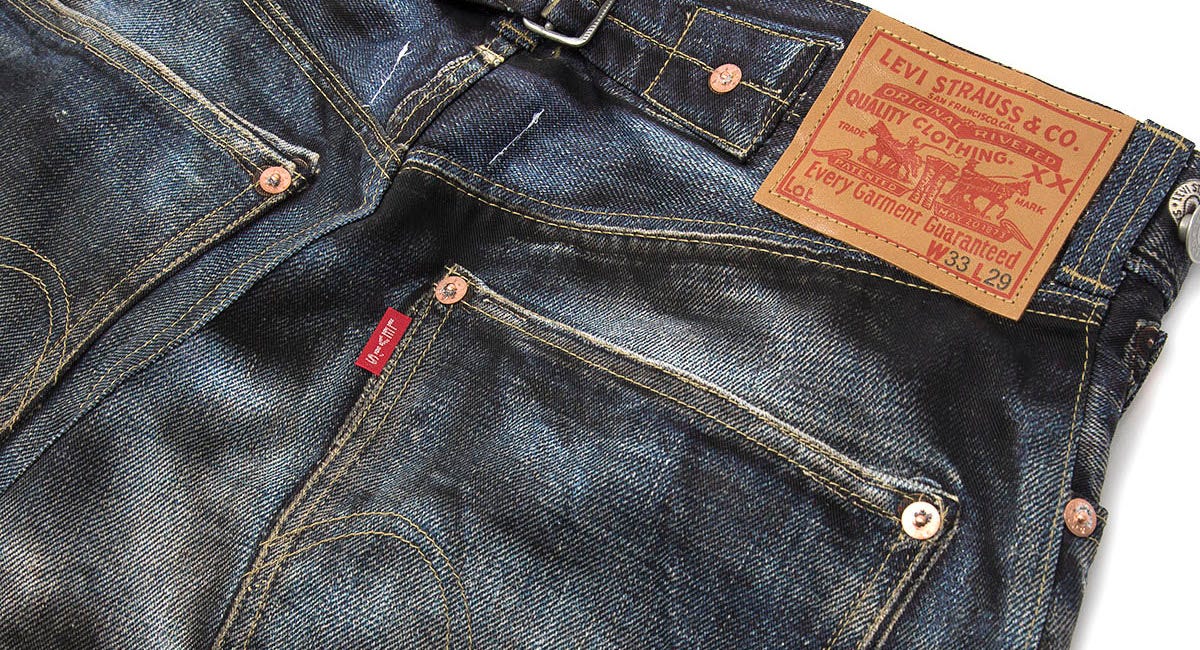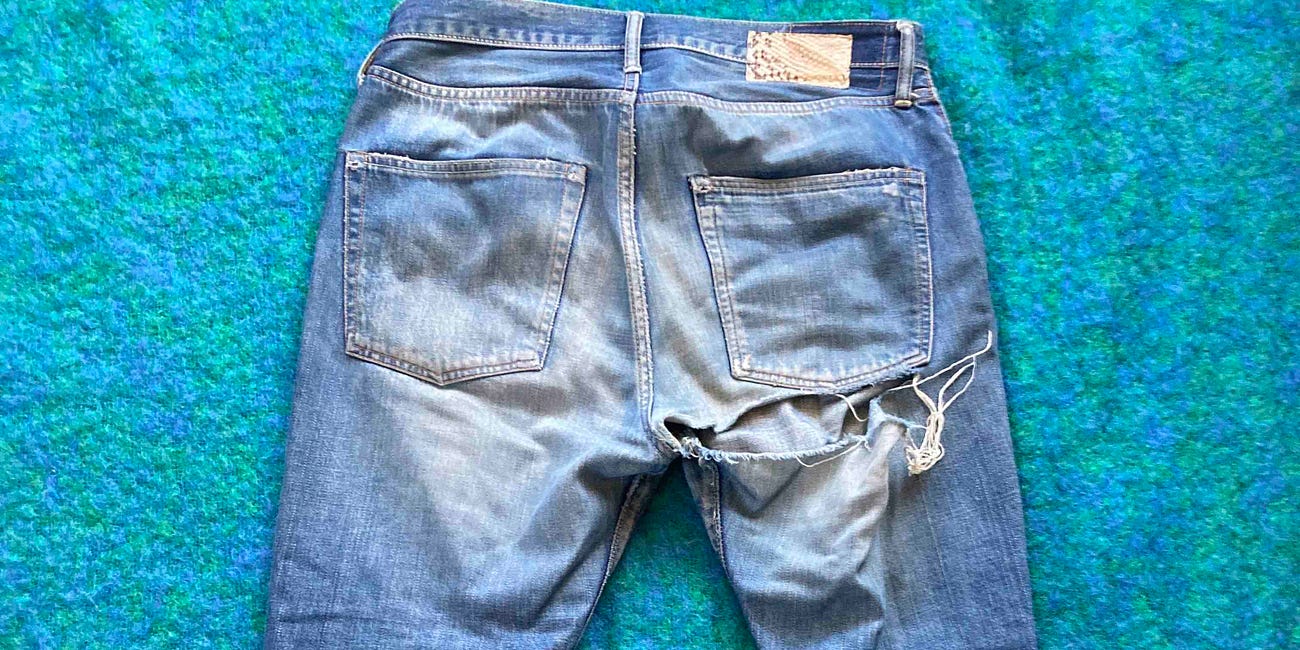I received a vulnerable text last week informing me that I could no longer wear denim at work.
I understand the reasoning for this in the literal sense. We are asked to wear very specific uniforms but told to do so in increasingly nonspecific ways. We are meant to represent our brand, our service, and our history by exuding luxury and elegance. This must not be in any way low class, dirty, scruffy, or encouraging of repair. Denim is in this category: simply too common.
But denim is my personal armor. It is the way I stay within myself in a luxury environment. Denim to me is the epitome of mixing high and low fashion aesthetics. Denim is an art form, a way of expressing, both utilitarian uniformity and the art of that uniformity. It is flexible and durable, but because of its versatility in any occasion, unacceptable.
I saw someone come into the luxury department store where I work wearing very skinny leg light wash denim and a matching coat, also slim, with a corduroy collar. Black boots. He was clean-cut, at ease, and the most beautiful if not most luxurious seeming person I encountered that day. I also regularly see baggy dark washes paired with camel-colored coats, not to mention the fashion-forward balloon-leg trousers with black blazers.
The store’s attitude towards denim is best reflected in the actual denim that they sell.
Aside from whatever designer garbs warp denim into worthiness via “couture cuts“ and logoism, there is the endless slop that is the contemporary denim market. This is stuff that makes Khaite look cutting edge, a sea of mediocrity, cheap simple, and always at least $200. Denim here is never luxurious because it is well crafted, but because people can be fooled into buying something expensive for no reason.
Contemporary denim is “armor” in as much as it fools a viewer into thinking the wearer is nonchalant, casual, and free. It protects the wearer from the idea that they spend money loosely, from caring about labels about newness and about “fashion.”
There is a sect of designers who craft denim that is both precious & expensive yet bizarre, or ultra-durable, or storied, or delicately tailored, or reenacted from a decades-old pair, or some combination. Junya Watanabe is not often mentioned in this club, yet his scale and obsessive knowledge of Americana yield fascinating results of the edges of denim possibility.
Recently he has dabbled with denim uniformity, last season showing denim coats that had the front and back of a pair of jeans sewed onto the coat’s hem, making the wearer look as if they had on a denim skirt, or at least two pairs of pants. He’s made flared pants in odd grays and whites devoid of color or fade, Levi’s with all details and pockets enlarged, and elegant opera coats and capes.
For his strict SS25 menswear show, Watanabe explicitly focused on denim as a pliable material and symbol. Denim could be a suit, workwear jacket, and subcultural symbol all at once. For the occasion, Watanabe brought back a trick from SS22. Here, he worked with legendary vintage denim purveyor Berberjin to source Levi’s nearly a century old and copy them exactly, however only in a sense. Levi’s jackets and pant silhouettes were replicated in light nylon and cotton, the details of tattered, faded, ancient vintage printed exactly on their surfaces.
I adore these pieces not simply because they were the first clothes I wrote critically about, but for their meta attitude toward denim authenticity and ephemerality. They provide the illusion of decades-long durability, of having paid the exorbitant price for original turn-of-the-century denim, of attunement to denim cult and Americana obsession. They cut the armoring power of denim down to its symbolic roots, made ironic by the comparative flimsiness of nylon.
Watanabe’s menswear always features denim, but his womenswear is usually sparser. This season, his SS25 show for women was marked by silver synthetic coats and dresses that resembling jagged race cars. Metal, fabric, synthetic, light all blend between layers of buckled, secret pockets, and reflective strips. Its futurist armor lands somewhere between a scrap metal anime mecha and a Picasso-proportioned muse in Gore-Tex. Denim is the subtler, cheaper option in the SS25 women’s collection - a more unusual sort of armor.
Watanabe’s Levi’s “oversized jacket“ is sold in both the men’s and women’s collection. This jacket represents a total denim uniformity. Its size envelops the wearer loosely and comfortably. Its minutely mottled wash is artisinal and expensive. The Levi’s label becomes a of subcultural sigil of subcultural authenticity.
However, this title buries the lede of what makes this garment special : “the vest overlay.” On the front and back of the jacket are the cutouts of a denim vest sewn on top of the jacket. This is the Watanabe’s true sleight of hand, the illusion of a layer and thus an extra durability. The fringe and stitching keeping the vest attached give the denim an illusion of even greater rarity, of a more precarious/precious work. And finally, that vest outline implies a three piece Canadian tuxedo. An ultimate protection via total denim ensemble.
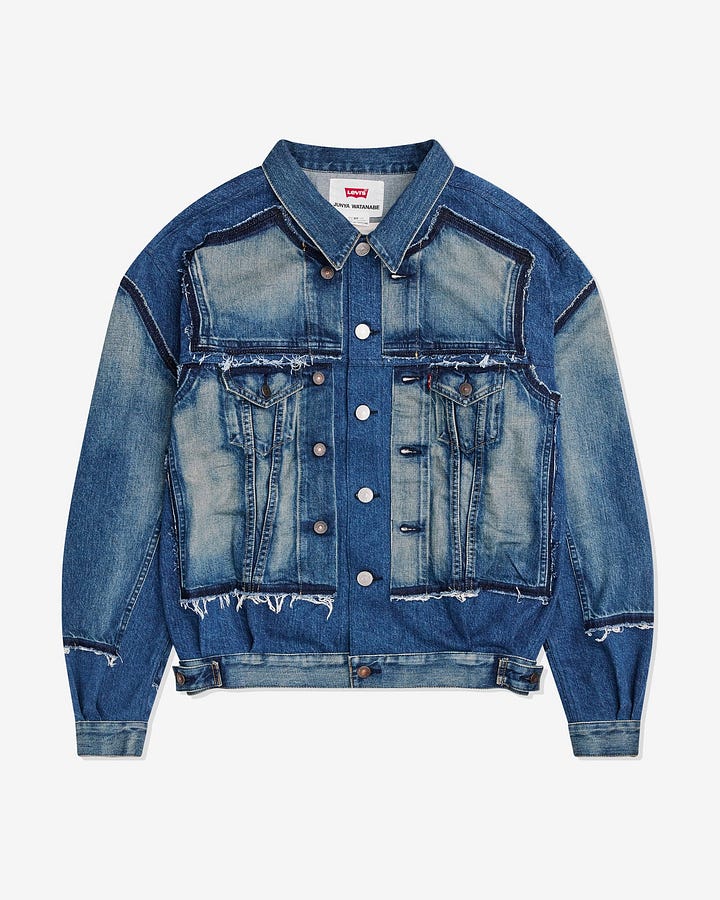
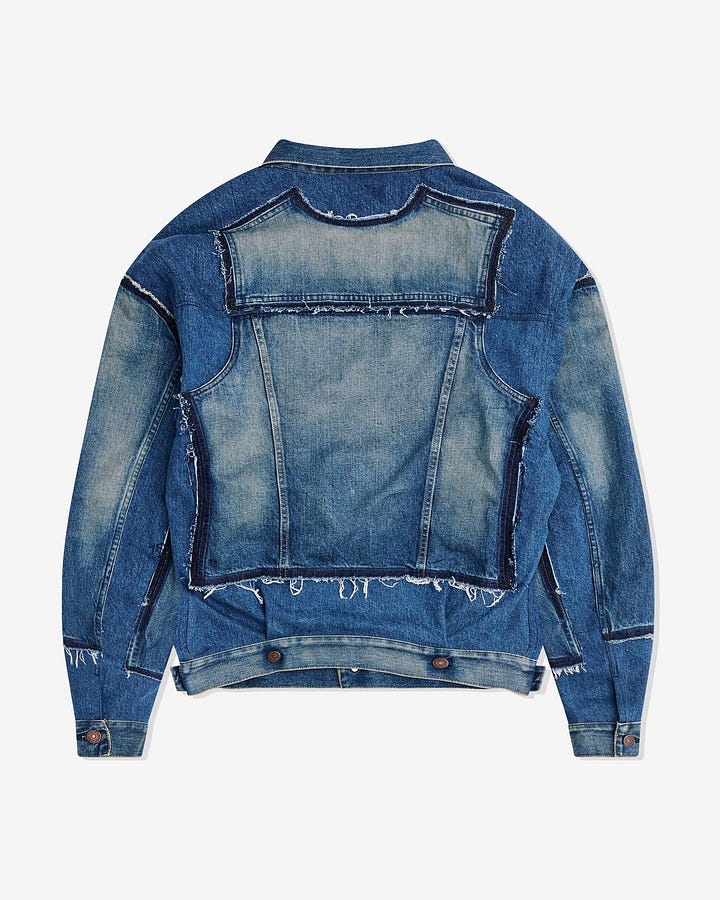
Inversely, the vest becomes a sort of bullseye that signals that these armoring techniques are unreliable - that this is not true vintage denim, that its durability is suspect if not staged, that its implication of a layered denim look is disrupted in deconstruction.
What is so vulnerable and powerful about this denim jacket is that its trick is available for anyone to see. It can protect you, but without mystique. I looked at the surface of this denim jacket and saw reflected exactly what I wanted from it.
I do not know if this is why I didn’t try it on when I encountered it. Perhaps it was too vulnerable, perhaps too easy.
Watanabe’s inverse treatise on denim armor is the wrap jeans. Here is a pair that looks like two, with one falling precariously down into a slit at the leg - a cut that seemed to mix European fashion with American texture. Even the leg that isn’t sliced is a cut skinny - showing off the body in every regard. the wrap implies the femininity of a gown, of high rise trousers, of skin and denim’s collision, of a Western sex. It carries an avant garde strangeness in construction yet inversely suggests the slouch of pants that fall. It is high concept and louche, casually sexy and intelligent.
Denim is no longer luxury via metaphor, price, or suggestion, it is transmogrified into pure shape, flow, and accentuation of body - no longer any pretension of “workwear“ remains. The denim reveals by design, it is an anti-armor, a celebration of vulnerability.
To put the pair on, the front of the jeans completely unravels to reveal a two dimensional outline of the denim front. The pants are held by two button closures, one at the right hip where the denim slants down, the other slightly lower at the left hip. When I try them on I actually am forced to button them differently, as they are too tightly secured, creating a far more avant garde (and revealing) folding of the denim revealing almost my entire leg. However, If worn properly these jeans secure tightly around the waist.
The wrap jeans create the illusion of vulnerability and access, of precariousness. Not so. This is a pair of jeans that hugs and holds, that locks firmly about the waist to calculatedly reveal only so much. The access and flow the jeans suggest is entirely reigned by the wearer. This denim offers a whole new sense of safety and armor in crafting the terms of their openness. This pair of pants is the kinder, the sexier, the loving denim armor.
Denim can be used to disrupt class distinction, blur the boundaries of social/subcultural association, and upend understandings of the body. What denim makes us feel safe? How to feel safe in revelation and transformation? Perhaps this is why I’m so drawn to Watanabe’s latter pair, to its generosity in reforming the body, and reforming gendered association. The way it blurs is so freeing. Ironically, I think I am obsessed that I cannot fit in them.
Watanabe’s armors are a testament to the ongoing implication of the body in clothing experiments, and the specific category denim takes on in that discourse. As frustrated as I am to see denim eliminated from my accepted uniform, it tickles me to see that such puritan attitudes about fabric still exist to spit in the face of. It’s a relief to see denim remain contested territory, ugly or sexual or low or dirty or rough.
It is a challenge to allow denim to be everything it is told it is not while remaining just as rough. I am thrilled denim can remain an oxymoron.
If you want more on Watanabe’s denim:
Printing Vintage: Junya Watanabe’s Art of Replica
This past spring I was tricked inside a high-end clothing store. When I entered the section dedicated to Comme Des Garcons protege Junya Watanabe, I discovered denim jeans covered in constellations of creases, ripples, and patched tears. These were the sort of jeans with discernible histories between their folds, and in their landscapes of artful repair…
If you want more on denim:
Paranoia & Americana
Heartbreak can happen in an instant. Brutally and without warning, a handful of seconds may strip you of a peaceful week or a joyous day. Last week this happened to me in the crisp exaggerated ripping sound I heard as I felt the tear below the back pocket of my favorite jeans. They were a Japanese selvedge denim pair from Visvim, 01D4 Fluxus Denim with …
If you want more on what my job wants me to wear:
Inside Out
I almost never had to wear a uniform, and I’ve recently decided that this is tragic. On childhood sports teams I wore the itchy jerseys and slouchy PE uniforms as long as I had to, but I was never forced into the strict garb of Catholic schools, boarding schools, Boy Scouts, or even a subconscious subcultural dress code. In the working world, namely, th…






